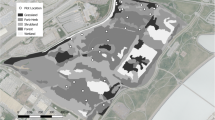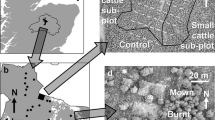Abstract
Trampling as an ecological factor is a major concern of the management of park, forest, nature preserves, and wilderness areas as recreational resources. Of particular importance to the management concept of carrying capacity is the relative resistance of native plant communities, to trampling and the resilience or the capacity of impacted communities to recover. This information can be used by management to establish seasonal use limits to prevent irreversible degradation of these resources. The purpose of this study was to follow the recolonizaton of experimental trail surfaces barren of vegetative cover and hiked at three levels of use intensity. Results of this study indicate that soil compaction as measured by soil penetration resistance increased progressively with use level while the total number of species, species diversity, and dominant index scores declined. A major finding was that the greatest degree of change occurred at the first level of hiking, indicating that major floristic measures were most affected by the least amount of hiking. Recolonization of impacted areas that received 100 trampling passes as measured by plant cover, dominant indices, floristic dissimilarity, and species diversity was similar to areas receiving four and eight times more trampling, despite major differences in soil penetration resistance. These data suggest limited use delivered at one time can be as damaging as increasing levels of use delivered at over time.
Similar content being viewed by others
Literature Cited
Bell, K., and L. C. Bliss. 1973. Alpine disturbance studies: Olympic National Park, U.S.A.Biological Conservation 5: 25–32.
Burden, R. F., and P. F. Randerson. 1972. Quantitative studies of the effects of human trampling on vegetation as an aid to the management of semi- natural areas.Journal of Applied Ecology 9:439–457.
Campbell, S. E., and G. W. Scotter. 1975. Subalpine revegetation and disturbance studies. Mount Revelstoke National Park. Unpublished report. Canadian Wildlife Service, Edmonton, Alberta, Canada. 99 pp.
Cole, D. N.. 1978. Estimating the susceptibility of wildland vegetation to trailside vegetation.Journal of Applied Ecology 15:281–286.
Cole, D. N. 1985. Recreational trampling effects on six habitat types in western Montana. USDA Forest Service, Research Paper INT-350, Ogden, Utah. 43 pp.
Cole, D. N. 1979. Reducing the impact of hikers on vegetation: An application of analytical research. Papges 71–78in Proceedings, Recreation Impact on Wildlands Conference, Seattle, Washington, US Department of Agriculture, Forest Service, Pacific Northwest Region.
Cole, D. N., and E. G. Schreiner. 1981. Impacts of backcountry recreation: Site management and rehabilitation—an annotated bibliography. USDA Forest Service General Technical Report INT-121. Ogden, Utah. 53 pp.
del Moral, R. 1979. Predicting human impact on high elevation ecosystems. Pages 292–303in Proceedings, Recreational Impact on Wildlands Conference, Seattle, Washington, US Department of Agriculture, Forest Service, Pacific Northwest Region.
Dissmeyer, G. E., and G. R. Foster. 1980. A guide for predicting sheet and rill erosion on forest land. USDA Forest Service Technical Publication SA-TP11. Atlanta, Georgia. 40 pp.
Hall C. N.. 1989. Using impact indices and baseline vegetation data to assess the condition of a wilderness. A case study of the Dolly Sods Wilderness, Mononghala National Forest, West Virginia. PhD dissertation. Univesity of Maryland, College Park, Maryland. 320 pp.
Hall, C. N., and F. R. Kuss. 1989. Vegetation alteration along trails in Shenandoah National Park, Virginia.Biological Conservation 48: 211–227.
Holmes, D. O., and H. E. M. Dobson. 1976. Ecological carrying capacity research: Yosemite National Park; Part I: The effects of human trampling and urine on subalpine vegetation—a survey of past and present backcountry use and the ecological carrying capacity of wilderness. US Department of Commerce, National Technical Information Service, No. PB270-955. 147 pp.
Hudson, M.. 1977. Fortymile River: Biological aspects of carrying capacity. Unpublished report. USDI Bureau of Land Management, Tok, Alaska. 52 pp.
Kuss, F. R.. 1983. Hiking boot impacts on woodland trails.Journal of Soil and Water Conservation 38: 119–121.
Kuss, F. R., and J. M. Morgan, III. 1984. Using the USLE to estimate the physical carrying capacity of natural areas for outdoor recreation planning.Journal of Soil and Water Conservation 39:383–387.
Kuss, F. R., A. R. Graefe, and J. J. Vaske. 1987. Recreation impacts and carrying capacity: A review and synthesis of ecological and social research. National Parks and Conservation Association, Washington, DC. 249 pp.
Lemons, J.. 1979. Coefficient of community and carrying capacity for a sub-alpine meadow. Pages 33–60in Proceedings, Second Conference on Scientific Research in the National Parks. San Francisco, California, USDI National Park Service.
Leonard, R. E., P. W. Conklin, and J. L. McMahon. 1984. Recovery of a bryophyte community on Hurricane Island, Maine. USDA Forest Service Research Note NE-325 Broomall, Pennsylvania. 4 pp.
Leonard, R. E., J. L. McMahon, and K. M. Kehoe. 1985a. Hiker trampling impacts on eastern forests. USDA Research Paper NE-555. Broomall, Pennsylvania. 5 pp.
Leonard, R. E., P. W. Conklin and J. L. McMahon. 1985b. The response of plant species to low-level trampling stress on Hurricance Island, ME. USDA Forest Service Research Note NE-327. Broomall, Pennsylvania. 6pp.
Liddle, M. J.. 1975. A selective review of the ecological effects of human trampling on natural ecosystems.Biological Conservation. 7:17–36.
Marshall, T. J., and J. W. Holmes. 1979. Soil physics. Cambridge University Press, London. 345 pp.
Marshand, P. J.. 1980. High elevation revegetation in eastern United States: State-of-the-art and problem analysis. Un published Report, NE23-156. USDA Forest Service, Broomhall, Pennsylvania. 33 pp.
Morgan, J. M., III, and F. R. Kuss. 1986. Soil loss as a measure of carrying capacity in recreation environments.Environmental Management 10:263–270.
Morgan, R. P. C. 1983. The impact of recreation on mountain soils: Toward a predictive model for soil erosion. Pages 112–121in N. G. Bayfield and G. C. Barrow (eds.), The ecological impacts of outdoor recreation on mountain areas in Europe and North Arnerica Recreation Ecology Research Group Report #9, R.E.R.G. Meeting Brathay Hall, Ambleside, Cumbria, Sept 9–12, 203 pp.
Parsons, D. J.. 1979. The recovery of Bullfrog Lake.Fremontia 7:9–13.
Price, M. F.. 1983. Management planning in the sunshine area of Canada's Banff National park.Parks 7:6–10.
Reid, W. H.. 1979. Vegetative structure, physical environment and disturbance in White Sands National Monument, New Mexico. Pages 71–85in Proceedings of the Second Conference on Scientific Research in the National Parks. San Francisco, California. USDI National Park Service.
Scotter, G. W.. 1976. Recovery of subalpine meadows under protection after damage by human activity: Yoho National Park. Unpublished report., Canadian Wildlife Service, Edmonton, Alberta.
Shannon, C. E., and W. Wiener., 1963. The mathematical theory of communication. University of Illinois Press, Urbana.
Siccama, T. G., F. H. Bormann and G. F. Likens. 1970. The Hubbard Brook Study: Productivity, nutrients and phytosociology of the herbaceous layer.Ecological Monographs 40:389–402.
Speight, M. C. D.. 1973. Outdoor recreation and its ecological effects: A bibliography and review. Discussion papers in conservation. 4. University College, London. 35 pp.
Stohlgren, T. J. 1982. Vegetation and soil recovery of subalpine campsites in Sequoia National Park, California. Master's thesis. California State University, Fresno. 49 pp.
Taylor, H. M., and E. Burnett. 1963. Influence of soil strength on root-growth habits of plants.Soil Science 98: 174–180.
Thorud, D. B., and S. S. Frissell, Jr.. 1976. Time changes in soil density following compaction under an oak forest.Minnesota Forest Research Note 257: 4 pp.
USDA Soil Conservation Service. 1972. Soil survey of Somerset County, southern part. Orono., Mexico.
Willard, B., and J. Marr. 1971. Recovery of alpine tundra under protection after damage by human activity in the Rocky Mountains of Colorado.Biological Conservation 3:131–190.
Author information
Authors and Affiliations
Rights and permissions
About this article
Cite this article
Kuss, F.R., Hall, C.N. Ground flora trampling studies: Five years after closure. Environmental Management 15, 715–727 (1991). https://doi.org/10.1007/BF02589629
Issue Date:
DOI: https://doi.org/10.1007/BF02589629




